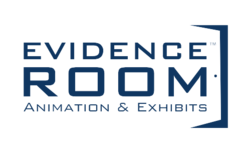How Forensic Animation Brings a Case to Life
Numerous studies have shown us that people understand a story or idea better when they see it, not just hear it being explained. This is particularly true when trying to explain a complicated medical concept to a judge and jury who are not experts in the matter. How can you explain a medical malpractice suit or personal injury case to a person or group of people who don’t fully understand anatomy and science? You can bring in the team at Evidence Room to present forensic animation!
Scene reconstruction done with 3D animations is a fundamental tool able to be used in legal presentations. It is especially helpful in personal injury, criminal defense, medical malpractice, wrongful death, and civil rights cases where determining a verdict can be a very difficult task. Demonstrative evidence can be a powerful persuasion tool. Our forensic animations allow the jury and judge to see the evidence as it relates to the causation of the events, not just hear you explain it.
Forensic animation uses the same computer-driven technology and advanced forensic science used by law enforcement. The images are compiled from a variety of sources and perspectives, including eyewitness statements, camera footage, police officers, forensic experts, engineers, and even autopsies. It offers you the following benefits:
#1 It can show the whole story. Video or photos taken at the scene of an event can only present facts from one perspective. One or two frames can’t always tell the whole story. Forensic animation, on the other hand, recreates the entire event. It can do so from multiple perspectives. It can even slow down action, pause, or zoom in to reveal critical details. For a car crash, the animation could include data gathered at the scene, details about the terrain, weather, and traffic conditions at the time of the accident.
#2 It makes complicated anatomy and science easier to understand. In medical malpractice cases, computer-aided animation is used to explain medical conditions or injuries. Chances are pretty good your jury isn’t full of doctors. They may not understand why a medical professional’s mistake caused the patient’s death or why their action was even a mistake in the first place. Medical animation will show them what happened in a way that’s easy to understand.
#3 The jury will remember it better. Your jury is listening to hours or even days of testimony. According to research, 80% of people remember what they see, compared to 10% what they hear and 20% of what they read. If you want them to remember your side of the argument when it’s time to deliberate, you need to present it in a way that sticks with them!
Don’t go to court alone! Evidence Room is here to help you present your side of the argument in a way that is far easier to comprehend, even for someone who isn’t an expert in the field. Don’t just tell them, show them!
Call Now For Your FREE Consultation
(216) 502-0400
